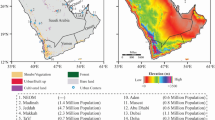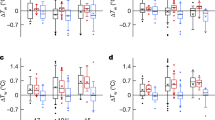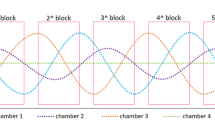Abstract
Changes in air temperature (AT), humidity and wind speed (Wind) affect apparent temperature (AP), the human-perceived equivalent temperature1,2,3. Here we show that under climate warming, both reanalysis data sets and Global Climate Model simulations indicate that AP has increased faster than AT over land. The faster increase in AP has been especially significant over low latitudes and is expected to continue in the future. The global land average AP increased at 0.04 °C per decade faster than AT before 2005. This trend is projected to increase to 0.06 °C (0.03–0.09 °C; minimum and maximum of the ensemble members) per decade and 0.17 °C (0.12–0.25 °C) per decade under the Representative Concentration Pathway 4.5 scenario (RCP4.5) and RCP8.5, respectively, and reduce to 0.02 °C (0–0.03 °C) per decade under RCP2.6 over 2006–2100. The higher increment in AP in summer daytime is more remarkable than in winter night-time and is most prominent over low latitudes. The summertime increases in AT-based thermal discomfort are projected to balance the wintertime decreases in AT-based discomfort over low and middle latitudes, while the summertime increases in AP-based thermal discomfort are expected to outpace the wintertime decreases in AP-based thermal discomfort. Effective climate change mitigation efforts to achieve RCP2.6 can considerably alleviate the faster increase in AP.
This is a preview of subscription content, access via your institution
Access options
Access Nature and 54 other Nature Portfolio journals
Get Nature+, our best-value online-access subscription
$29.99 / 30 days
cancel any time
Subscribe to this journal
Receive 12 print issues and online access
$209.00 per year
only $17.42 per issue
Buy this article
- Purchase on Springer Link
- Instant access to full article PDF
Prices may be subject to local taxes which are calculated during checkout




Similar content being viewed by others
References
Steadman, R. G. Norms of apparent temperature in Australia. Aust. Met. Mag. 43, 1–16 (1994).
Gaffen, D. J. & Ross, R. J. Climatology and trends of U.S. surface humidity and temperature. J. Clim. 12, 811–828 (1999).
Tikuisis, P. & Osczevski, R. J. Facial cooling during cold air exposure. Bull. Am. Meteor. Soc. 84, 927–933 (2003).
Delworth, T. L., Mahlman, J. D. & Knutson, T. R. Changes in heat index associated with CO2-induced global warming. Climatic Change 43, 369–386 (1999).
Steadman, R. G. The assessment of sultriness. Part I: A temperature–humidity index based on human physiology and clothing science. J. Appl. Meteorol. 18, 861–873 (1979).
Robinson, P. J. On the definition of heat wave. J. Appl. Meteorol. 40, 762–775 (2001).
Gill, J. S., Davies, P., Gill, S. K. & Beevers, D. G. Wind-chill and the seasonal variation of cerebrovascular disease. J. Clin. Epidemiol. 41, 225–230 (1988).
Mora, C. Global risk of deadly heat. Nat. Clim. Change 7, 501–506 (2017).
Dunne, J. P., Stouffer, R. J. & John, J. R. Reductions in labour capacity from heat stress under climate warming. Nat. Clim. Change 3, 563–566 (2013).
Fischer, E. M. & Knutti, R. Robust projections of combined humidity and temperature extremes. Nat. Clim. Change 3, 126–130 (2013).
Curriero, F. C. et al. Temperature and mortality in 11 cities of the Eastern United States. Am. J. Epidemiol. 155, 80–87 (2002).
Gasparrini, A. et al. Mortality risk attributable to high and low ambient temperature: a multicountry observational study. Lancet 386, 369–375 (2015).
McMichael, A. J. et al. Human Health and Climate Change in Oceania: A Risk Assessment (Commonwealth Department of Health and Ageing, Canberra, 2003).
Huang, C. et al. Projecting future heat-related mortality under climate change scenarios: a systematic review. Environ. Health Perspect. 119, 1681–1690 (2011).
Ebi, K. L. & Mills, D. Winter mortality in a warming climate: a reassessment. WIREs Clim. Change 4, 203–212 (2013).
Huber, V., Ibarreta, D. & Frieler, K. Cold- and heat-related mortality: a cautionary note on current damage functions with net benefits from climate change. Climatic Change 142, 407–418 (2017).
Steadman, R. G. A universal scale of apparent temperature. J. Clim. Appl. Meteorol. 23, 1674–1984 (1984).
Dee, D. P. et al. The ERA-Interim reanalysis: configuration and performance of the data assimilation system. Q. J. R. Meteorol. Soc. 137, 553–597 (2011).
Uppala, S. M. The ERA-40 re-analysis. Q. J. R. Meteorol. Soc. 131, 2961–3012 (2005).
Kalnay, E. et al. The NCEP/NCAR 40-year reanalysis project. Bull. Am. Meteorol. Soc. 77, 437–471 (1996).
Kanamitsu, M. et al. NCEP-DOE AMIP-II reanalysis (R-2). Bull. Am. Meteorol. Soc. 83, 1631–1643 (2002).
Taylor, K. E., Stouffer, R. J. & Meehl, G. A. An overview of CMIP5 and the experiment design. Bull. Am. Meteorol. Soc. 93, 485–498 (2012).
Serreze, M. C. & Barry, R. G. Processes and impacts of Arctic amplification: a research synthesis. Glob. Planet. Change 77, 85–96 (2011).
Willett, K. M., Gillet, N. P., Jones, P. D. & Thorne, P. W. Attribution of observed surface humidity changes to human influence. Nature 449, 710–713 (2007).
Fischer, E. M. & Schär, C. Consistent geographical patterns of changes in high-impact European heatwaves. Nat. Geosci. 3, 398–403 (2010).
Diffenbaugh, N. S. & Giorgi, F. Climate change hotspots in the CMIP5 global climate model ensemble. Climatic Change 114, 813–822 (1999).
IPCC Climate Change 2013: The Physical Science Basis (eds Stocker, T. F. et al.) (Cambridge Univ. Press, 2013).
Rothfusz, L. P. The Heat Index Equation (or, More Than You Ever Wanted to Know About Heat Index). National Weather Service Technical Attachment (SR90-23) (NWS, Fort Worth, TX, 1990).
Buck, A. L. New equations for computing vapor pressure and enhancement factor. J. Appl. Meteorol. 20, 1527–1532 (1981).
Wanielista, M., Kersten, R. & Eaglin, R. Hydrology: Water Quantity and Quality Control (Wiley, Toronto, 1997).
Osczevski, R. & Bluestein, M. The new wind chill equivalent temperature chart. Bull. Am. Meteor. Soc. 86, 1453–1458 (2005).
Sillmann, J., Kharin, V. V., Zhang, X., Zwiers, F. W. & Bronaugh, D. Climate extremes indices in the CMIP5 multimodel ensemble: Part 1. Model evaluation in the present climate. J. Geophys. Res. Atmos. 118, 1716–1733 (2013).
Hamed, A. F. & Rao, A. R. A modified Mann–Kendall trend test for autocorrelated data. J. Hydrol. 204, 182–196 (1998).
Snedecor, G. W. & Cochran, W. G. Statistical Methods. 8th edn (Iowa State Univ. Press, Iowa City, 1989).
Acknowledgements
The authors acknowledge the World Climate Research Programme’s Working Group on Coupled Modelling, which is responsible for CMIP, and acknowledge the climate modelling groups for developing and making available their model output. For CMIP5, the US Department of Energy’s Program for Climate Model Diagnosis and Intercomparison provides coordinating support and led development of software infrastructure in partnership with the Global Organization for Earth System Science Portals. The work described in this Letter was supported by the Research Grants Council of the Hong Kong Special Administrative Region, China (project no. HKBU22301916) and a Direct Grant of The Chinese University of Hong Kong (project no. 4052134).
Author information
Authors and Affiliations
Contributions
J.L. and Y.D.C. designed the study. J.L. conducted the analysis. J.L., Y.D.C., T.Y.G. and N.-C.L. discussed the results and jointly wrote the paper.
Corresponding author
Ethics declarations
Competing interests
The authors declare no competing financial interests.
Additional information
Publisher’s note: Springer Nature remains neutral with regard to jurisdictional claims in published maps and institutional affiliations.
Supplementary information
Supplementary Information
Supplementary Discussions 1–8, Supplementary Figures 1–45, Supplementary Methods, Supplementary Table 1, Supplementary References
Rights and permissions
About this article
Cite this article
Li, J., Chen, Y.D., Gan, T.Y. et al. Elevated increases in human-perceived temperature under climate warming. Nature Clim Change 8, 43–47 (2018). https://doi.org/10.1038/s41558-017-0036-2
Received:
Accepted:
Published:
Issue Date:
DOI: https://doi.org/10.1038/s41558-017-0036-2
This article is cited by
-
Exploring the relationship between land use/land cover and apparent temperature in China (1996–2020): implications for urban planning
Scientific Reports (2024)
-
Trend, driving factors, and temperature-humidity relationship of the extreme compound hot and humid events in South China
Theoretical and Applied Climatology (2024)
-
Record-breaking High-temperature Outlook for 2023: An Assessment Based on the China Global Merged Temperature (CMST) Dataset
Advances in Atmospheric Sciences (2024)
-
A daily high-resolution (1 km) human thermal index collection over the North China Plain from 2003 to 2020
Scientific Data (2023)
-
Recent changes in temperature extremes in subtropical climate region and the role of large-scale atmospheric oscillation patterns
Theoretical and Applied Climatology (2022)



